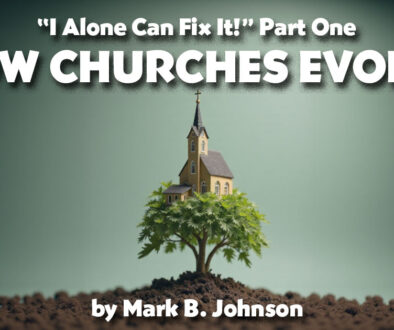“I Alone Can Fix It,” Part 2: Wholism
by Mark Johnson | 24 June 2025 |
(Read part 1 of this series here.)
In this installment I’m discussing an idea of central importance to Adventists—one that has largely been sidelined. It’s called wholism.
Our doctrine of wholism (and for my purposes, the “w” seems essential) has often fallen under the rather dreary heading of the state of the dead. We have historically used this to make sure the body stays in the grave until the resurrection, and to prevent any belief in or confusion regarding spirits, ghosts, and apparitions.
That may be of importance, but I believe wholism is much more significant than that. A key to the whole Adventist identity is the idea that humans are complete, individual, indivisible, multidimensional units. We are not isolated quantities joined together in combination during human life and separated again at death. The basic idea is that a human being is not an additive aggregate, but an integral entity.
But it also informs the way we look at church structure and organization. I will make the argument that wholism is the principle that underpins at least three important characteristics of our movement: our total dependence on God, the health message, and church unity.
It potentially ensures our very survival.
Salvation by dependence
The belief in wholism is fundamental to our understanding of sin and salvation. The basis of sin is a self-centered sense of self-sufficiency. If we are immortal souls, there is, indeed, something inherent within us that guarantees an afterlife. We have some autonomy apart from God. Some type of survival is built into us.
But wholism says “no.” Only God is self-sufficient. We are intrinsically mortal. There is nothing within us that survives death independently. A future life depends on God’s remembering and resurrecting us. When we die, we remain only in the mind of God. Not only are we remembered as individual personalities, but somehow God retains our characters and our own memories in His infinite intelligence. Because we return to the dust, we are totally dependent on Him for the future. He resurrects our bodies, but He also revives our personalities. He restores our characters. Our essential selfhood is completely subject to His memory. Any future is absolutely tied to Him.
Additionally, the spiritual preparation for eternal life depends on wholism. It reminds us that not only is our physical future dependent on God, but we are also totally dependent on Him for salvation in the first place. There is no self-sufficient way to be righteous. We don’t have some spiritual essence that can overcome self-centeredness on its own by rising above or escaping the material self. Our salvation depends on our trusting God to save us.
The now-antique Seventh-day Adventist Bible Commentary on Ephesians 5:30 says:
“As the life that sustains the vine flows to the branches and becomes the source of their life (John 15:1-8), so the believer gathers all his spiritual life and graces from Christ. He can do nothing of himself, and he would perish spiritually – and eventually physically – if separated from his Lord” (SDABC Vol 6, pp. 1037, 1038).
We can’t be righteous on our own. There is no inner spirit or soul that overcomes our deficiencies. Salvation comes only from complete trust in our Creator and Redeemer. The Sabbath, a rather unique gift to Adventists, every week reminds us of this total dependence on God, both physically and spiritually.
The health message
My paternal grandmother joined the Adventist church because of the health message. The care of the human body was very important to her. It was and is also important to us as a people. The preservation of health is seen as a religious duty. The body has spiritual significance. “A sound body,” the saying goes, “is required for a sound intellect.”
At various times and in numerous other movements, the human body has been viewed as simply a decadent container for the earth-bound soul. Gnosticism, which had a great influence on early Christianity, taught that spirit was an ethereal good, and physical matter—including the human body—was intrinsically evil. This belief still affects the sexual attitudes of many Christians, including some Adventists.
It was our belief in wholism, the idea that the spirit and body are intrinsically united, that directly led to our emphasis on physical health. Healthy living and the care of the body is prominent in our movement. We proudly claim that the ministerial care of the spirit and the physical care of the body make up the two inseparable arms of our church.
Blame it on Loma Linda
In 1909, to adequately promote wholism, we established an Adventist medical school—back then called the College of Medical Evangelists—in Loma Linda, California. The next year, in 1910, the Carnegie Foundation published a report by Abraham Flexner that described the deplorable state of medical education in North America. It included detailed descriptions of each medical school operating at that time. The report called on medical schools to enact higher standards for admission and graduation, and to adhere strictly to mainstream scientific principles.
As a result of this report, more than half of all American medical schools either merged or closed. Accreditation of the remaining medical schools became essential.
To maintain the College of Medical Evangelists in Loma Linda, California, the Adventist church was forced to improve the educational levels of both the faculty of the medical school and the students being admitted. This led the church in two different, but related, directions.
At that time, more of our medical school faculty were preachers than physicians. To meet accreditation standards, Adventist scholars in the sciences were, for the first time, encouraged to seek graduate education in “worldly” institutions.
Accreditation changed everything
With our medical school’s being forced to enact higher admission standards to gain and retain accreditation, a domino effect in our Adventist feeder schools soon followed. To produce qualified applicants for medical school, our colleges, academies, and eventually even our elementary schools faced requisite accreditation. Teachers and faculty members at all levels needed to meet higher standards of education.
This radically changed the face and future of Adventism. Sensing—and fearing—where this would lead, some Adventist leaders opposed accreditation, and advocated for the closure of the College of Medical Evangelists. Ellen White, however, insisted that our medical school must remain open. Indeed, it must aim to reach the highest educational standards. It must be fully accredited. Its graduates should stand on an equal educational and intellectual footing with skilled and competent physicians from other noteworthy medical schools. I believe she well knew what the impact of such an action would have on all of Adventist education.
The transformative consequences of wholism to our institutions are still seen today. We are far more prominent than our size should warrant. We have both the largest Protestant healthcare system globally, and the largest Protestant educational system in the world. According to Adventist Archives, we have 10,381 educational institutions worldwide, including 107 college and university campuses. We have 733 healthcare institutions worldwide, including clinics and hospitals. In the early 1980s, over 40% of all medical missionary physicians were Adventists.
Having well-educated science teachers in our schools led to the desire for the improved training of teachers in other fields, too, and in other Adventist colleges. Faculty and graduate students seeking education “out there” in the world brought back new, innovative, creative—and problematic—ideas. They challenged the church’s status quo. Interestingly, but not surprisingly, the teachers of religion were the last group to seek further graduate education outside of our own academic arena. This had the unintended effect of giving students the feeling that religion was not as intellectually demanding as the other arts and sciences. It began to form a crack in the foundation of our unity.
Next: How we failed at unity, and what we can do about it now.
 Mark B. Johnson is a graduate of Pacific Union College and Loma Linda University, with a medical residency at Johns Hopkins University in Preventive Medicine and Public Health. He is a retired local public health officer from the Denver metropolitan region. He’s an adult Sabbath School class teacher and church board vice-chair at the Boulder Adventist church.
Mark B. Johnson is a graduate of Pacific Union College and Loma Linda University, with a medical residency at Johns Hopkins University in Preventive Medicine and Public Health. He is a retired local public health officer from the Denver metropolitan region. He’s an adult Sabbath School class teacher and church board vice-chair at the Boulder Adventist church.




